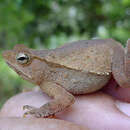Brief Summary
provided by IABIN
Diagnosis A species belonging to the Rhinella margaritifera group, characterized by: (1) medium size for the group (snout-vent length 39.4-52.1 mm in males); (2) snout rounded in dorsal view, with a vertical apical ridge which gives a nearly mucronate aspect; (3) snout nearly acute in profile; (4) antorbital and supra-orbital crests developed, parietal crest poorly developed; (5) post-orbital crest large, forming a lateral ledge; (6) tympanum evident; (7) vertebral apophyses generally not salient on dorsum or with four tubercles poorly salient; (8) presence of a dorsolateral line of spinulose tubercles on the external border of the parotoid gland, continuing along the lateral side of body to the groin; (9) a rounded tubercle at the posterior corner of mouth; (10) vocal slits present in males.
- author
- Esteban O. Lavilla
- editor
- Diego Arrieta
Distribution
provided by IABIN
Distributed along the Atlantic Rain Forest of Eastern Brazil, from the State of Ceará to the State of Paraná.
- author
- Esteban O. Lavilla
- editor
- Diego Arrieta
Diagnostic Description
provided by IABIN
Description of the holotype Body robust; head wider than long, head width 35% of snout-vent length. Snout rounded in dorsal view, with a vertical apical ridge which gives a nearly mucronate appearance; in profile, nearly acute. Top of snout and head slightly concave; canthus rostralis well defined by the canthal crests, curved; loreal region concave. Nostrils lateral, protuberant, slightly directed backwards, nearer to the tip of snout than to eyes; internarial distance smaller than the eye-to-nostril distance, eye diameter and upper eyelid width, and larger than the tympanum diameter; eye-to-nostril distance smaller than the eye diameter, approximately equals the upper eyelid width, and larger than the tympanum diameter; eye diameter larger than the upper eyelid width, length of post-orbital crest, and tympanum diameter; upper eyelid width 60% of interorbital distance. Antorbital and supra-orbital crests developed, parietal crest poorly developed; post-orbital crest large, forming a small lateral ledge; post-orbital crest length 95% of eye diameter. Tympanum large, vertically elliptical, with a distinct annulus; horizontal diameter of tympanum 93% of the vertical diameter and 70% of post-orbital crest length. Parotoid glands, in dorsal view, small, elliptical; in lateral view, elliptical, separated from the post-orbital crest by a small notch; parotoid gland length larger than the post-orbital crest length. External border of the parotoid gland with a line of pointed tubercles which continues along the lateral side of body to the groin. Vertebral apophyses not salient on dorsum. Lips not flared; eyes visible from below. A V-shaped incision in the maxilar symphysis; a small rounded tubercle at the posterior corner of mouth. Vocal sac subgular, poorly developed; vocal slits small, lateral to the tongue. Choane small, lateral, widelly separated; tongue large, two times as long as wide, free and not notched behind. Forelimbs robust, forearms as robust as arms; a line of small pointed tubercles along the lateral border of forearm. Hand with long, slender fingersnot webbed, in crescent order of size, IIVariation in type series Presents small variation in measurements. Regarding the color pattern, however, there is great variation, with three very distinctive types. One type, as described for the holotype, presents the dorsum uniformly brown without a mid-dorsal line, or with a poorly defined mid-dorsal line, and further without a mid-dorsal line but with the fore and hindlimbs darkened to a grayish brown. The second pattern appears in few specimens and is composed by a cream mid-dorsal stripe bordered by black, head and interorbital area black forming a distinctive lozengeshaped stain, lateral side of head and body black, and ventral surface black on gular region and chest, and gray on anterior half of belly, suffusing in gray and cream on the posterior half of belly and ventral surfaces of thighs. Finally, one specimen presents dorsum and venter uniformly brown, with only a distinctive mid-dorsal cream stripe.
- author
- Esteban O. Lavilla
- editor
- Diego Arrieta

